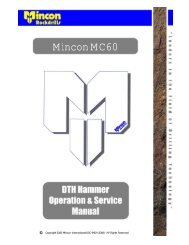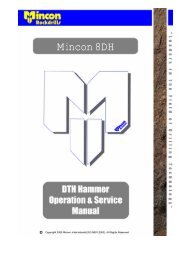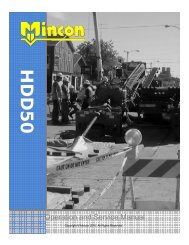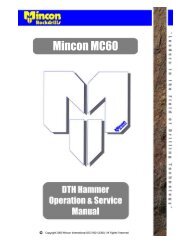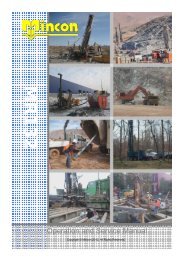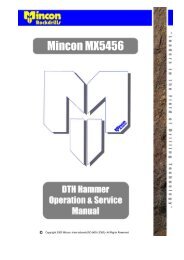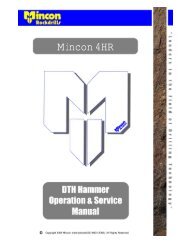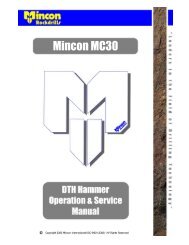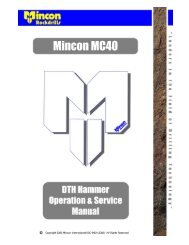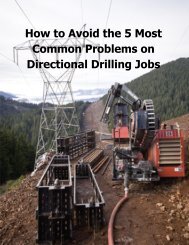HDD30
Mincon HDD30 Service Manual - Manufacturer of Top Quality ...
Mincon HDD30 Service Manual - Manufacturer of Top Quality ...
- No tags were found...
You also want an ePaper? Increase the reach of your titles
YUMPU automatically turns print PDFs into web optimized ePapers that Google loves.
<strong>HDD30</strong>Operation and Service ManualCopyright © Mincon 2010, All Rights Reserved.
TABLE OF CONTENTSTable of Contents .......................................................................................... 21 Introduction ............................................................................................... 32 Installation and Operation ......................................................................... 42.1 Safety ....................................................................................................................................... 42.2 Set up of <strong>HDD30</strong> Hammer and Sonde ..................................................................................... 42.2.1 Storage .......................................................................................................................................................... 42.2.2 Setup of Sonde .............................................................................................................................................. 42.2.2.1 Installation of DCI Sonde.................................................................................................................................................. 42.2.3 Installation of Bit ............................................................................................................................................. 82.3 Setup and Operation of Support Station .................................................................................. 92.3.1 Set up of Support Station ............................................................................................................................. 102.3.2 Equipment Inspection Prior to Compressor Ignition .................................................................................... 122.3.3 Pressure Regulator Adjustment ................................................................................................................... 132.3.4 Oiler Adjustment .......................................................................................................................................... 132.3.5 Water Pump Adjustment and Operation ...................................................................................................... 132.3.6 Commissioning of Hammer ......................................................................................................................... 142.3.7 Lubrication ................................................................................................................................................... 142.3.8 Operation of Hammer .................................................................................................................................. 142.4 Servicing ................................................................................................................................ 162.4.1 General ........................................................................................................................................................ 162.4.2 Opening Chuck and Backhead .................................................................................................................... 162.4.3 Dismantling Hammer to Change Drill Bit ..................................................................................................... 172.4.4 Disassembly for Full Servicing of Hammer .................................................................................................. 172.4.5 Inspection ..................................................................................................................................................... 172.4.6 Checking Wear Limits .................................................................................................................................. 172.4.7 Reassembly ................................................................................................................................................. 173 Appendix ................................................................................................. 193.1 <strong>HDD30</strong> exploded view and Parts List ..................................................................................... 193.2 <strong>HDD30</strong> Hammer Service Log ................................................................................................ 204 Warranty ................................................................................................. 21Mincon – “Leaders in Rock Drilling Technology” Page 2
1 IntroductionThis document covers the <strong>HDD30</strong> Horizontal Directional Drilling System. The system connected to the drill using the following:• <strong>HDD30</strong> Horizontal Directional Hammer• Support Station• Compressor• Water supplyThe basic setup is shown below.Horizontal Directional DrillIncluding but not limited to:Astec DD1416Ditch Witch JT1220, JT922Vermeer 9X13, 16X20CompressorMinimum 100 PSISupport StationRock Drill Oil InjectionWater injectionCompressor to Drill adapterWater TankDust ControlSonde Cooling2-4 Gal/MinThe Installation and Operation section will deal with setup of the system and basic operation. Following that we will deal withdisassembly and servicing. When dealing with the <strong>HDD30</strong> in the service section we will separate it into two parts: Firstly the HorizontalDirectional Drilling hammer component that makes drilling possible and secondly the Sonde housing component that makes steeringpossible.Mincon – “Leaders in Rock Drilling Technology” Page 3
2 Installation and Operation2.1 SafetyBe sure to work safely at all times. Wear protective clothing and safety equipment and observe all safety regulations as prescribed byyour employer, Government, or the site on which you work. Do not wear loose clothing that may get caught in rotating parts and causeserious personal injury. Remember that a “Horizontal Down-the-Hole” percussive hammer emits noise and you should therefore takeevery precaution to safeguard your hearing against damage by using proper ear protectors.Use eye protection at all times. Rock chips and dust which may be discharged from the face of the bit or bore hole at high velocitiesand can cause severe injury. Hammers can be heavy – Always use proper and approved lifting equipment and take every precautionto safeguard yourself against injury. Keep hands clear at all times – Beware of getting fingers trapped between the chuck and bit anddo not use hands or feet to clear the top of the borehole at any time. Other safety advice is given throughout this document which youare advised to read.2.2 Set up of <strong>HDD30</strong> Hammer and Sonde2.2.1 StorageIf you intend to store the <strong>HDD30</strong> Hammer we recommend that ½ pint (¼ litre) of good quality rock drill oil be poured into the hammer toprotect it. To do this the hammer section should be unscrewed from the Bent Sub and then the oil should be poured into the top of thehammer and let flow down into the piston chamber of the hammer to coat the parts and protect them from rust and corrosion. Oncecompleted the bent sub and the Sonde Housing can be reinstalled. Ensure that the thread protector and chuck cap are fitted to keepdebris out and to prevent oil leakage. Store the hammer horizontally in a clean dry place.2.2.2 Setup of SondeWhen the <strong>HDD30</strong> is supplied it will contain the necessary parts for the successful installation of a commercial Sonde. The two maintypes of Sonde are dealt with in this manual: DCI Sonde and Sub Sight.2.2.2.1 Installation of DCI SondeThe following series of picture will detail the installation of an 8” DCI Sonde into the <strong>HDD30</strong>. The same procedure should be used forservicing or changing the Sonde at a later date.STEP 1 STEP 2Unscrew and remove Sonde Housing Backhead from theSonde Housing SleeveInsert and screw the Sonde Line Up Tool into the SondeCarriage retrieval cap and pull out the complete SondeCarriage assembly.Mincon – “Leaders in Rock Drilling Technology” Page 4
Step 3 Step 4Unscrew and remove the Sonde Carriage Locating Cap,Springs and the DCI Adapter from the Sonde Carriage (AtOpposite end to the Sonde Carriage retrieval cap)Loosen and remove with the Torque Wrench the DCI AdaptorLocating cap from the tube. The correct end has locatingdimple.Step 5 Step 6Insert and push the DCI Sonde into the tube.Fit the DCI Adaptor Locating cap onto the DCI Sondeensuring the Locating cap’s intrical key is seated correctly inthe Sonde Keyway.Mincon – “Leaders in Rock Drilling Technology” Page 5
Step 7 Step 8 Step 9 Step 10Push the Sonde in the rest ofthe way and screw the DCIAdaptor Locating Cap in andtighten snugly with the Torquewrench.Insert first spring into theSonde Carriage.Insert the DCI Adaptor intothe Sonde CarriageInsert the second spring into the Sonde Carriage.Sonde CarriageLocating CapGrooveDCI AdaptorLocatingDimpleStep 11 Step 12 Step 13Align the Sonde Carriage Locating CapGroove with the DCI Adaptor LockingDimple and push the cap on so that thehex socket of the Carriage Locating Capfits over the DCI Adaptor and then screwthe Carriage Locking Cap in placePush the Sonde carriage into the SondeHousing Sleeve with the Sonde CarriageLocating cap entering first.Screw the Retrieval bar into theSonde Carriage and push forwarduntil it stops. Turn gently until youfeel the Sonde Carriage go forwardand the Sonde Carriage Locking Capgroove seats over the Sonde CarriageLocating pin (See Step 14 for detailsof the pin).Mincon – “Leaders in Rock Drilling Technology” Page 6
2.2.3 Installation of BitThe following sequence of instructions is used to correctly fit the bit in the correct orientation for drilling.Step 1 Step 2Unscrew and remove the Chuck from the Hammer.Remove Bit Retaining Ring from the Chuck and screw the Chuckback in place.Step 3Insert the bit into the Chuck so that the Bent Sub wear carbides are aligned in a straight line with the three bit wear carbides asillustrated above.Mincon – “Leaders in Rock Drilling Technology” Page 8
Step 4 Step 5Unscrew the Chuck and Bit from the hammer making sure thatthe bit does not come out of the Chuck.Insert the Bit Retaining Rings back into the Chuck as shownabove making sure that the Bit does not come out of the Chuck.Step 6Push the Chuck forward to secure the Bit Retaining Ring in place against the rear splines. Screw the Chuck, Bit and Bit RetainingRings in place.2.3 Setup and Operation of Support StationPrior to operation the Support Station must be setup to ensure that correct and safe operation of the equipment is carried out.CAUTION – For safe working conditions during operation of the equipment it is essential to have received the appropriate training priorto starting up the equipment.Mincon – “Leaders in Rock Drilling Technology” Page 9
2.3.1 Set up of Support StationSupport Station30’ Air Hose20’ Air HoseTRI-LiteValveControllerWater HoseWhip Checks2” NPT CouplingsStep 1Unpack Support Station and check to make sure all components are present.Step 2 Step 3 Step 4Support Station comes delivered with whipchecks in place on both the air intake anddischarge lines. Enlarge loop on the otherend of the whip check on the air intake valveend and loop over air hose and release.Connect air hose to Support Station airintake valve.When completed pull whip checksback so that they are as shownabove. Above picture shows airdischarge side of support station.Mincon – “Leaders in Rock Drilling Technology” Page 10
Step 5 Step 6 Step 7Connect air hose to the compressor in thesame manner. Connect other air hose toSupport Station discharge line and to Drillalso using the same procedure.Hook TRI light controllerconnections to electric valveBefore Operation, check level of oil in thewater pump fill cap with dip stick.Step 8CAUTION: Always follow these instructions when filling tank with rock drill oil.1. Turn compressor off and shut valve off at compressor.2. Turn electric valve off make sure you see a red light on the Tri-Lite Controller and Red or Yellow indicator on the top of valveis pointing perpendicular to valve body.3. Open vent valve (Labelled #1 Vent Valve above) lower right hand control knob, relieving air pressure inside of tank toatmospheric air pressure.4. After air has bled out of tank, use hammer to hit four inch hammer fitting on top of tank counter clockwise to loosen, and thentake off by hand.5. Fill oil to top of tank, but not past fitting in the middle of the neck.6. Refit Oil tank cap and tighten using a hammer.CAUTION: Always make sure 4” cap is tight on tank and vent valve is closed before starting compressor.Mincon – “Leaders in Rock Drilling Technology” Page 11
2.3.2 Equipment Inspection Prior to Compressor IgnitionCAUTION: The following walk around check should be carried out prior to starting the compressor.Step Specific Equipment Required State Complaint()1 Hose connecting Drill to Support StationRED Air flow arrow goes to Drill. Hose connectedto outlet valve.2 Hose connecting compressor to Support Station Connected at electric inlet valve.3 Inlet and Outlet Valve ConnectionsWing nuts tightened using hammer turningclockwise.4Inlet and outlet valves on Support Station WhipChecksConnected correctly as described in abovesections.5 Hose to compressor connection6 Hose to compressor connection Whip Check7 Hose to Drill connection8 Hose to Drill connection Whip CheckWing nuts tightened using hammer turningclockwise.Connected correctly as described in abovesections.Wing nuts tightened using hammer turningclockwise.Connected correctly as described in abovesections.9 4” Wing Nut on top of Rock Drill Oil Tank Tightened using hammer turning clockwise.10 Rock Drill Oil Tank Vent ValveClosed (knob pointing toup as in Photo)11 Main Air Discharge valve (2” Valve to Drill) Open (Parallel to Valve Body)12 Power Connections for Tri-Lite Controller13 Tri-Lite Controller Valve Operation14 Tri-Lite Controller ValveConnected to 12V Battery – Black to NEGATIVE(-) and Red to POSITIVE (+)Operating correctly – Red light means air off(Valve closed) Green light air on (Valve Open)Red light – air off (Valve closed) prior to startingcompressorMincon – “Leaders in Rock Drilling Technology” Page 12
2.3.3 Pressure Regulator AdjustmentOn a new support station, the pressure regulator needs to be set at80 PSI. To adjust the pressure after the walk around inspection andthe compressor is operational, turn the Air Discharge Valve (Valve toDrill - 2” ball valve) off, Turn electric valve on (green light on) this willpressurize the system.Adjust the regulator clockwise to turn air pressure up and counterclockwise to turn pressure down. Set pressure gauge to 80 PSI.After adjustment turn electric valve off (red light) and turn AirDischarge Valve on, handle parallel to the valve body.CAUTION; Operating at higher pressures may cause motor todevelop an air lock and stop operating.2.3.4 Oiler AdjustmentThe amount of oil is dependent on where the needle valve is set. Theneedle valve is located on the far left as shown here. Turning the valvecounter clockwise provides more oil and clockwise gives less oil. A goodstarting point is to close the valve fully and then turn one and a halfrevolutions to the counter clockwise. The two valves located on the controlpanel (see photo) are how you turn the oiler on and off. During drilling thetwo valves should be ON. When not drilling turn valves OFF.CAUTION: At the end of the day turn the valves off or you will be wastingoil. The oiler will continue to oil whether compressor is on or off. It isrecommended that on a new system, until the operator is familiar with thesystem that after each rod is drilled down ¼ cup or two ounces of rock drilloil be poured in each rod, especially if a new hammer is beingcommissioned.2.3.5 Water Pump Adjustment and OperationAlways prime water hose before hooking the cam lock to the pump. It is essential to have the water tank above the support station tomaintain sufficient head pressure for the pump to operate.The amount of water being introduced into the drilling operationis controlled by turning the knob labelled water on front panel todesired amount of flow. The amount of water required tomaintain a clean hole will be dependent on the drillingconditions. Approximately 3-4 gallons per minute will sufficehowever in softer rock conditions more water may be requiredand significantly harder conditions will require less. Once theoptimal water injection is set the water will turn off when theoperator turns off the main air supply to the drill and converselyturn on when the main air supply is turned on. It is best to adjustthe water while drilling as conditions can change throughout thebore hole.CAUTION: Never turn the water pump on with the main discharge valve (2” Ball valve to Drill) on the support station closed. Thewater should always have a path out and through the drill string. Always use clean water. Bentonite should not be used as this will clogup the hammer requiring a complete overhaul to return the hammer to an operable condition. A good mixture of polymer and Condet isacceptable if drilling in clay. Check the in-line filter on the pump periodically for debris. In colder conditions antifreeze the pump anddrain the 40 foot water hose and clean and empty the in-line filter to protect from freezing while not operating the drill.Mincon – “Leaders in Rock Drilling Technology” Page 13
2.3.6 Commissioning of HammerCoat the drill bit shank and the hammer threads with grease for protection and easier dismantling. Prior to use, lubricate the hammerwith ½ pint (¼ litre) of rock drill oil as described above.Fit the hammer to the drilling rig ensuring no debris or dirt enters the hammer from the site, dirty tubes or from unclean air lines. Makesure that the coupling threads from the drill are of the same specification to that of the hammer and they are in good condition.Run the hammer at half the air flow for a few minutes to allow the oil to flow through and for internal components to settle in.2.3.7 LubricationIt is vital for HDD hammers to receive a constant supply of proper rock drill oil to protect the internal components and to provide a goodair seal between the piston and the inner cylinder, and the piston and the wear sleeve for efficient drilling. The correct consumption ofoil is dependent upon the air volume and conditions. Please refer to the lubrication graph below for recommendations. When drilling inwet conditions the normal amount should be doubled. There should be visual evidence of oil around the drill bit shank and within thetube joints when changing tubes.1500Litres/Hour0.5 1 1.5 2.0 2.542.0Pressure - Bar6.9 13.8 20.7 27.6 34.5120 48.9125035.010037.8Air Volume - CFM100075050025028.021.014.07.0Air Volume – M 3 /MINAmbient Temperature ºF80604020ISO320ISO15026.715.64.4-6.7Ambient Temperature ºC0-17.81 2 3 4 5US Pints/HourIn wet drilling (above 2gpm/8 lpm) the oilconsumption should be doubledISO46-20 -28.9100 200 300 400 500Pressure - PSIThe recommended grade of oil is dependent on the ambient temperature in which drilling is taking place as well as the operatingpressure. As a rule of thumb, ISO320 grade rock drill oil should be used whenever possible as the hammer is a high frequency tool,however, where the pump cannot pump the oil in colder conditions, a lower grade of oil can be used as per the graph above.Remember: Insufficient lubrication or incorrect lubrication grades may result in damage being caused to the hammer and itscomponents. Hydraulic oils, engine oils, gear oils and diesel are not recommended for lubricating HDD hammers.2.3.8 Operation of HammerBe sure to familiarize yourself with the controls of the machine and work in accordance with the manufacturers recommendations.The percussive mechanism begins to operate as the air supply is turned on and when the drill bit is pushed firmly into the hammer.Excessive thrust pressures are not needed to make it work. The thrust controls on the drill should be adjusted to the correct pressureand should be readjusted to take account of the weight of any extra tubes added so that the thrust pressure remains constant and notexcessive. Insufficient thrust pressure will make the hammer drill erratically and less efficiently and cause premature wear to the bitand chuck splines with likely damage to the hammer components and threads.Mincon – “Leaders in Rock Drilling Technology” Page 14
When the hammer is lifted from the rock face, the drill bit extends from the chuck and the percussive action ceases. Extra air will passthrough the hammer, which can be used to flush the hole clean.Rotation speeds should not be too high and should be selected to suit drilling conditions and drill bit diameters. High rotation speeds donot provide fast drilling and can cause premature wear of drill bits, hammers and tubes. Too slow a rotation speed can cause binding inthe borehole and damage to drill bit inserts.The controls of the drill should be adjusted in order to provide the largest drill chip size with the smoothest rotation and feedcharacteristics. Recommended rotation speeds would normally vary between 25 – 35 R.P.M. for most applications.Where big diameter drill bits are used or when drilling in hard abrasive rocks, slower rotation speeds are recommended. Conversely, insoft, non-abrasive rock a slightly faster rotation speed may be selected to produce more satisfactory results.Some ground conditions may cause binding within the hole, with the added risk of the hammer and drill string becoming jammed. Anyexcessive pullback forces or high rotation speeds used in an attempt to recover the drill string may generate heat zones around thehammer, which may alter the metallurgy of the components to cause damage and ultimate failure.You are strongly advised not to pour diesel into the hammer as this may create an internal combustive effect and will damage thehammer and its components. Any heat induced failures are not covered by our terms of warranty.Before adding a drill rod make sure that the threads are clean and well greased and that there are no contaminants likely to enter thehammer to cause damage and early wear.Proper drill guides and break out systems must be used which suit the diameter of the hammer. All tools and spanners used for the drillbit and break out flats must fit properly.Make certain that the hammer is stationary when applying spanner or breakout tools. Do not rotate the hammer with a spannerattached to the drill string unless it is safely captivated within the breakout clamp.The Air Consumption of the hammer is as per the chart below. The chart represents operating pressure and equivalent airconsumption at sea level with an ambient temperature of 68°F (20°C).Mincon – “Leaders in Rock Drilling Technology” Page 15
Both temperature and altitude have an effect on air and consequently on compressed air. Higher temperatures and higher altitudesresult in air becoming thinner, less dense, and the effect of this is a reduction in a compressor’s delivery pressure.The table below shows just how much operating pressure can be affected by these two factors. For example, if we take a compressorwhich will deliver 1000 cfm at sea level, this same compressor will only deliver 745 cfm at 9,000ft, given a temperature of 40 degreesFahrenheit (4.4 degrees Celsius).°F °CSea Level 1000ft 3000ft 5000ft 7000ft 9000ft 11000ft 13000ft 15000ftSea Level 305m 915m 1524m 2134m 2744m 3354m 3963m 4573m-40 -40 0.805 0.835 0.898 0.968 1.043 1.127 1.217 1.317 1.426-30 -34.4 0.824 0.855 0.920 0.991 1.068 1.154 1.246 1.349 1.460-20 -28.9 0.844 0.875 0.941 1.014 1.092 1.180 1.275 1.380 1.494-10 -23.3 0.863 0.895 0.962 1.037 1.117 1.207 1.304 1.411 1.5280 -17.8 0.882 0.915 0.984 1.060 1.142 1.234 1.333 1.443 1.56210 -12.2 0.901 0.935 1.005 1.083 1.167 1.261 1.362 1.474 1.59620 -6.7 0.920 0.954 1.026 1.106 1.192 1.288 1.391 1.506 1.63030 -1.1 0.939 0.974 1.048 1.129 1.217 1.315 1.420 1.537 1.66440 4.4 0.959 0.994 1.069 1.152 1.241 1.341 1.449 1.568 1.69850 10 0.978 1.014 1.091 1.175 1.266 1.368 1.478 1.600 1.73260 15.6 0.997 1.034 1.112 1.198 1.291 1.395 1.507 1.631 1.76670 21.1 1.016 1.054 1.133 1.221 1.316 1.422 1.536 1.662 1.80080 26.7 1.035 1.074 1.155 1.244 1.341 1.449 1.565 1.694 1.83490 32.2 1.055 1.094 1.176 1.267 1.365 1.475 1.594 1.725 1.868100 37.8 1.074 1.114 1.198 1.290 1.390 1.502 1.623 1.756 1.902110 43.3 1.093 1.133 1.219 1.313 1.415 1.529 1.652 1.783 1.936120 48.9 1.112 1.153 1.240 1.336 1.440 1.556 1.681 1.819 1.9702.4 Servicing2.4.1 GeneralDismantling the Hammer for servicing or to change the bit can be made easier if the chuck threads are regularly greased and thebackhead threads are well greased any time the hammer is opened for servicing. We recommend that a good quality thread grease beused, and in acidic conditions, we do not recommend copper based greases as this can trigger a galvanic reaction with corrosive effectto damage the root of the threads and cause failure.2.4.2 Opening Chuck and BackheadThe threads used in Mincon Hammers are right hand threads. Proper tools and break-out systems should be used at all times todismantle HDD hammers, otherwise damage may be caused to the components which could result in eventual failure or affect theperformance of the Hammer. When using Petol wrenches or similar systems, ensure that the wrench is not placed on the threadedsection of the wear sleeve. Petol wrench jaws should be carbide, and in good condition. It is good practice to keep a spare set of jawswith the rig. Do not strike or hit the outer components as this could weaken the heat treated steels. Hitting the hammer may also causehard metal fragments to be chipped off which may be projected and cause personal injury or eyesight loss.Do not apply heat to the hammer, as this can alter the metallurgical composition and result in premature failure. Additionally, applyingheat can also cause distortion to the wear sleeve, which in turn would lead to failure. Do not trap the hammer under drill rig tracks orMincon – “Leaders in Rock Drilling Technology” Page 16
vehicle wheels which could cause bending and distortion of the hammer body. Failures caused by these actions cannot be supportedby warranty.Take care when dismantling the hammer to make sure that parts and drill bits do not become detached and cause damage or personalinjury.2.4.3 Dismantling Hammer to Change Drill BitWhen possible, dismantling the Hammer to change the drill bit is preferably best done in a workshop environment to avoid the risk ofinjury and for cleanliness. Be careful to ensure that the drill bit and chuck are fully supported together so that there is no risk of thembecoming detached and causing injury. This can occur if the O Ring on the bit retaining rings is missing or damaged. Before fitting anew drill bit visually inspect the splines of the chuck and the piston striking face to ensure that both are not damaged in any way. Fitnew bit as described in section 2.2.3 above.2.4.4 Disassembly for Full Servicing of HammerBreakout the Chuck and Backhead as described previously. Unscrew chuck and remove bit and bit retaining rings. Unscrew thebackhead and check to see if the check valve and spring are operating correctly, and then remove them. Mark one end to identifyeither the chuck or backhead end for reassembly latter.Stand hammer up with the chuck end uppermost. Using a mild steel bar, tap the strike face of the piston to remove the air distributorand inner cylinder. The steel make-up ring and lock ring should fall out during this process, if so remove them and continue until the topof the air distributor is at the top of the wear sleeve. The hammer can now be placed flat on the ground or put up onto a suitable vice,and using the mild steel bar, hit the piston strike face from the chuck end, to completely remove the air distributor, inner cylinder andpiston.The piston retaining ring can be removed by using a mild steel bar and hitting the section opposite the gap on the ring which will ride upthe taper on the wear sleeve and come out. It can then be pulled out by hand.2.4.5 InspectionPrior to inspection, thoroughly clean all parts using a suitable cleaning agent. Diesel is not recommended for cleaning as it can causeerosion to components, and damage to health.All parts should be visually inspected for any signs of damage, wear or cracking. The inner cylinder, wear sleeve and lock rings can bechecked for unseen cracking by suspending them and lightly tapping with a screw driver. If they emit a ringing tone then they should besound. However, a dull flat tone if emitted may indicate cracking, and the part should be replaced.Take particular care to check the internal bore of the wearsleeve for pick-up marks and galling. If these are present, the barrel of thewear sleeve should be honed out, using a hand hone to remove them.Inspect surface of the piston for pick-up marks and galling (usually caused through poor lubrication or the presence of contaminants)and smooth out with emery paper or a hand held grit stone. Where galling of the piston has occurred, substantial heat has beengenerated and quite often, micro cracking has occurred on the piston. In these cases, the piston should be replaced if there is evidenceof such cracking. Check the strike face of the piston for cracking or damage.2.4.6 Checking Wear LimitsThe performance of the hammer is dependent on the amount of wear the critical components have. These should be measured andrecorded in the Service log in the appendix. The service log gives the location of where measurements should be made. Dependingon how many parts need to be replaced, it may be economical to replace the hammer all together.2.4.7 ReassemblyThe hammer can be reassembled in the following manner, referring to the exploded view of the hammer in the appendix. Ensure allcomponents are liberally coated with good quality rock drill oil and threads with thread grease.After identifying which end will be the chuck end, fit the piston retaining ring in this end. This can be pushed into place, using a smallbar or screwdriver to ensure that it is seated correctly. Place the bit retaining pins in and screw the chuck in place. Again make sure tohave the thin end of the bit retaining rings at the blow tube end of the bit.Mincon – “Leaders in Rock Drilling Technology” Page 17
Turn wear sleeve over with the chuck on the floor, and drop the piston in with the strike face in first. Again ensure that fingers do notget caught between the wear sleeve and the piston.Place the three piece seating ring on the inner cylinder and secure in place with the seating ring O Ring. Insert The Air distributor intothe inner cylinder at the seating ring end and using a soft headed mallet, tap it into place so that it seats up against the top of the innercylinder.Place the inner cylinder assembly into the wear sleeve, and tap down with a soft headed mallet. When beginning to hit the assembly,ensure that it goes in square. Using a steel dolly, on top of the air distributor and inside the wear sleeve, drive the assembly into placewith a sledgehammer.Place the lock ring in on top of the air distributor and then the Steel Makeup Ring on top of that. Insert the spring and check valve inplace and finally screw the backhead in place. With the backhead in place, there should be a small gap between the backhead and thewearsleeve. This gap should be between 0.015” and 0.030”, and can be measured using a feeler gauge. If the gap is less than theminimum, then the lock ring will need to be replaced. Protect the hammer as earlier described by internal lubrication.Mincon – “Leaders in Rock Drilling Technology” Page 18
3 Appendix3.1 <strong>HDD30</strong> exploded view and Parts List18MINCON <strong>HDD30</strong> PARTS LIST ANDSPECIFICATIONS123456789101112131416151719202122232425262728293031323335Item Description Part no.MINCON <strong>HDD30</strong> HAMMER MHD201AS01SONDE HOUSING ASSEMBLY MHS201AS011 SONDE HOUSING BACKHEAD MHS201BH012 DIVERTER MHS202DV013 O-RING MHS221OR014 TOP SONDE SPACER MHS203TS015 O-RING MHS221OR016 COMPRESSION RING MHS205LR017 SONDE CARRIAGE (Short Range) HR5158 SONDE HOUSING SLEEVE MHS211SH019 O-RING MHS221OR0110 SEALING SLEEVE MHS204SL0111 O-RING MHS221OR0112 O-RING MHS221OR0113 BOTTOM SONDE SPACER MHS205BS0114 O-RING MHS221OR0115 LOCATING PIN MHS208LP0116 BENT SUB MHD201BH0217 CHECK VALVE MB302CV0118 CHOKE MB506CH01CHOKE 1/8 (3.2mm)MB506CH02CHOKE 3/16 (4.8mm)MB506CH0319 SPRING MB503SP0120 STEEL MAKE UP RING MS304SM0121 LOCK RING MS305LR0122 AIR DISTRIBUTOR MS307DR0223 O-RING MB321OR0124 O-RING MB322OR0125 SEATING RING MS309SR0126 INNER CYLINDER MS308IC0227 PISTON MS310PN0228 WEAR SLEEVE MHD211WS0129 PISTON RETAINING RING MS312PR0130 ALIGNER MHS313BB0131 BIT RETAINERS (4 Pieces) MHS313BR0232 CHUCK MHD214CK0133 BITMincon – “Leaders in Rock Drilling Technology” Page 19
3.2 <strong>HDD30</strong> Hammer Service LogWEARSLEEVE / PISTON CLEARANCEPart New Dimension As Measured Wear Actual Clearance Discard ClearanceWearsleeve A 2.453” (62.30mm) C C-APiston OD B 2.448” (62.19mm) D B-DChuck endC-D≥ 0.010” (0.25mm)CINNER CYLINDER / PISTON CLEARANCEPart New Dimension As Measured Wear Actual Clearance D Discard ClearanceCylinder ID A 2.114” (53.70mm) C C-AC-D≥ 0.010” (0.25mm)Piston OD B 2.110” (53.59mm) D B-DDCDISTRIBUTOR PROBE / PISTON ID CLEARANCEPart New Dimension As Measured Wear Actual Clearance Discard ClearanceDistributor Probe OD A 0.787” (20.00mm) C C-AC-D≥ 0.010” (0.25mm)Piston ID B 0.795” (20.20mm) D B-DCDALIGNER / PISTON CLEARANCEPart New Dimension As Measured Wear Actual Clearance Discard ClearanceAligner ID A 1.626” (41.30mm) C C-AC-D≥ 0.017” (0.40mm)Piston Nose OD B 1.614” (41.00 mm) D B-DDCEXTERNAL WEARDescription Wear Limit As MeasuredWearsleeve Discard Dimension:2.835” (72.0mm)Note: Chuck should be replaced when wear transfers to wearsleeve.Mincon – “Leaders in Rock Drilling Technology” Page 20
4 WarrantyMincon Hardrock Directional Drilling HammersWarranty, January 2005Mincon warrants that the Mincon Hardrock Directional Drilling Systems and spare parts therefore, manufactured by Mincon anddelivered to the initial user to be free of defects in materials or workmanship for a period of 3 months after initial operation or 6 monthsfrom the date of shipment to the initial user, whichever occurs first. Mincon may elect to repair the defective part or issue full or partialcredit towards the purchase of a new part. The extent of credit issued will be determined on a pro-rata basis bearing in mind the servicelife of the defective part against the normal service life of that part. The part will be replaced or repaired without charge to the initial userat the place of business of an authorized Mincon distributor during normal working hours. The user must present proof of purchase atthe time of exercising the warranty.The warranty applies only to failures resulting from defects in the material or workmanship and does not apply to failures occurring as aresult of abuse, misuse, corrosion, erosion, negligent repairs and normal wear and tear. Failure to follow recommended operating andmaintenance procedures which result in component failure will not be considered for warranty.This warranty is in lieu of all other warranties, other than title, expressed or implied.Limitation of Liability.Mincon will not accept any remedies to the user other than those set out under the provisions of warranty above. The total liability ofMincon or its distributors with respect to the sale of DTH Hammers or spare parts therefore, whether based on contract, negligence,warranty, indemnity or otherwise shall not exceed the purchase price of the product upon which such liability is based. Mincon and itsdistributors shall in no event be liable to any party relating to this sale for any consequential, indirect, special or punitive damagesarising out of this sale or any breach thereof, or any defects in or failure of or malfunction of the Mincon DTH Hammer or spare parts.Warranty will be voided where:• There is evidence of damage resulting from insufficient or incorrect lubrication.• There is evidence of misuse through the application of heat, welding or of being struck.• There is evidence of distortion or bending however caused.• There is damage caused as a result of using incorrect servicing tools or procedures.• If it is evident that the hammer or its components have achieved a reasonable proportion of their anticipated life.Mincon – “Leaders in Rock Drilling Technology” Page 21



